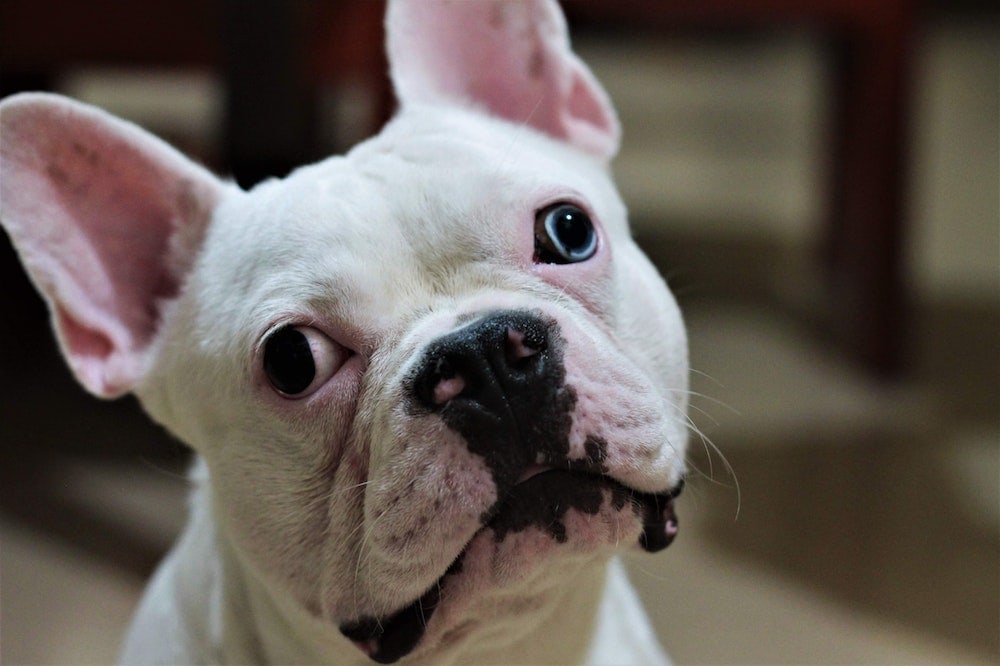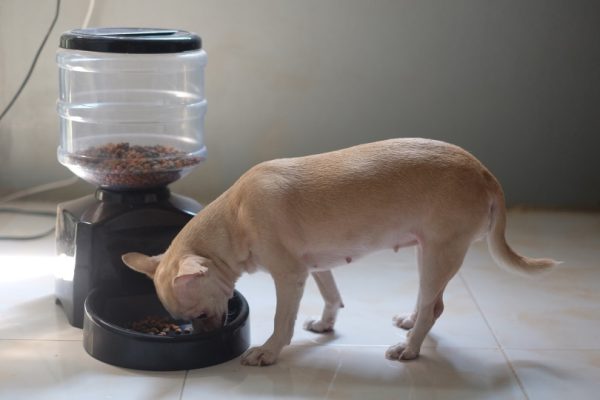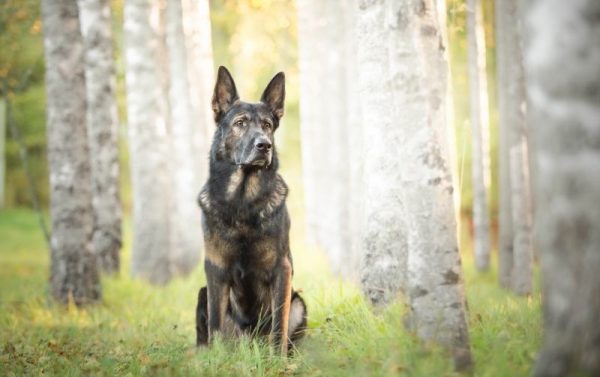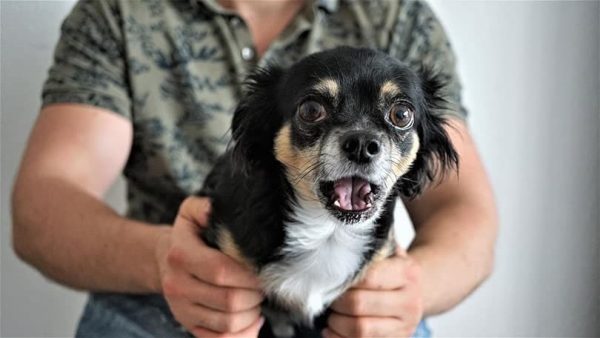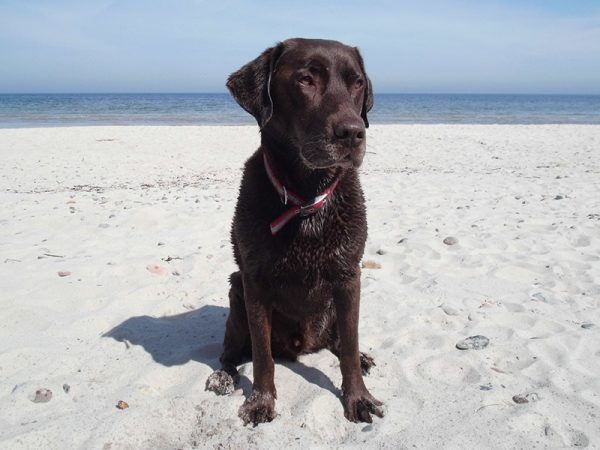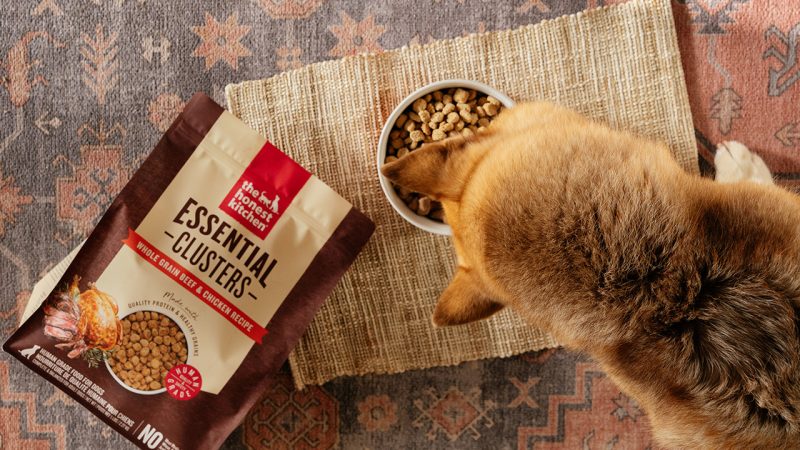In this article
In 2022, the French Bulldog took out the number one spot of the most popular dog breeds in America, a position held by the Labrador retriever for over three decades. Additionally, six of the 20 most popular breeds are considered to be brachycephalic, showing that the fondness for these short-faced dogs is more than just a passing trend.
Alongside their growing popularity, there has been an increasing awareness of the health and welfare issues that these breeds face, and Brachycephalic Syndrome has become a commonly used term in veterinary practice. But what does it actually mean?
Let’s take a look at what lies beneath the surface of these squishy little faces.

What Is Brachycephalic Syndrome?
Brachycephalic Syndrome, also known as Brachycephalic Obstructive Airway Syndrome (BOAS), refers to a set of conditions that affect breeds of dogs that have a shortened skull, or “brachycephaly.” Brachycephalic breeds have their origins in the barbaric sport of bull-baiting, made popular during the Elizabethan era. A shorter snout was a tactical advantage, allowing dogs to get closer to their opponent to inflict damage. Over time, people’s attraction shifted away from the bloodthirsty sport and onto the dogs themselves. The unique appearance of Bulldogs became popular among pet owners and breeders, leading to the intense selective breeding of individuals with shorter and shorter muzzles, with the emphasis being placed on appearance rather than functionality.


What Are the Causes of Brachycephalic Syndrome?
Bulldogs, Pugs, and French Bulldogs are among the most famous and worst affected brachycephalic breeds, with the Boston Terrier, Shih Tzu, Dogue de Bordeaux, Bull Mastiff, and Boxer amongst the long list of others. All brachycephalic breeds will suffer from BOAS to some extent, but it is the Bulldog, French Bulldog, and Pug that most commonly require veterinary attention as a result.
The external features of these breeds, while arguably cute and endearing, are only the tip of the iceberg with respect to what is happening internally. These snub-nosed creatures have all of the same anatomical structures as their elongated counterparts, but rather than being shorter, the structures are merely compressed 1. This results in a significant amount of soft tissue surrounding and obstructing the airways, causing the snorts, snuffles, snores, and strained breathing that are so characteristic of these breeds.
- Hypoplastic trachea (narrowing of the windpipe), often made worse by enlarged laryngeal saccules and surrounding soft tissue
- Stenotic nares (narrowed nostrils )
- Tongue and soft palate that are too large and long for the mouth, causing obstruction of the airways and difficulty swallowing
In addition to the obstructive airway issues, brachycephalic breeds also suffer from:
- Overcrowding of the mouth, often resulting in malpositioned teeth and a high risk of periodontal disease
- Brachycephalic Ocular Syndrome
- Pain and neurological problems due to the abnormal skull structure and compression of nerve tissue
- Spinal issues as a result of concurrently inherited vertebral malformation, particularly in pugs and French Bulldogs
- Gastric problems, such as vomiting and reflux, caused by difficulty swallowing and breathing
- Skin folds on the head and face that often become inflamed and infected
- Difficulty breeding—many brachycephalic breeds require cesareans, as the large, round heads of the pups are often too big to pass through the narrow pelvis. In addition, the extreme conformation of most Bulldogs means that they cannot reproduce without artificial insemination, which seriously calls into question the ethics of breeding these dogs.
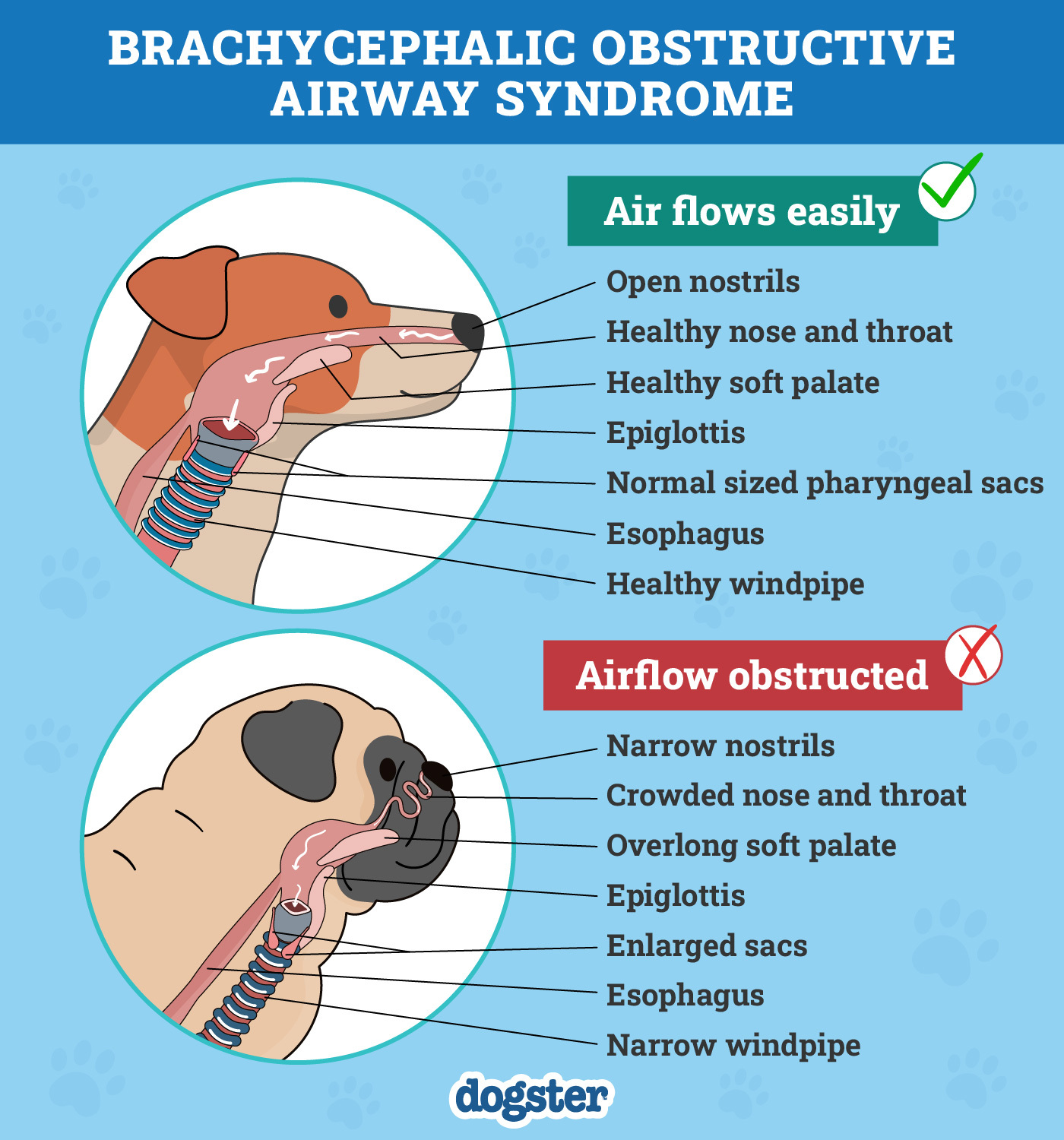

What Are the Signs and Consequences of Brachycephalic Syndrome?
Focusing specifically on BOAS, the clinical signs of a dog suffering from this syndrome are all the things we commonly associated with Bulldogs, Pugs, and French Bulldogs:
- Noisy, rapid breathing
- Excessive panting
- Protruding tongue
- Exercise intolerance
- Struggling in high temperatures
- Snoring
- Exaggerated swallowing
Individuals vary in degree of severity, but even dogs that show little to no obvious signs of brachycephalic syndrome will have some level of airway obstruction due to their anatomy.
If your pet is showing these signs, we suggest you speak to a vet.
If we consider an individual suffering from the worst version of all brachycephalic traits, we have a dog that is breathing air in through slit-like nostrils, past a compressed network of sinus, soft palate, and laryngeal structures, into a trachea with a diameter less than that of a drinking straw. They exhale out of that tiny trachea, through the thick and long soft palate, past a tongue that is always in the way.
The result of these issues is a dog that struggles to maintain adequate oxygen levels, particularly during exercise. As a dog’s primary cooling mechanism is evaporative cooling by panting, the brachycephalic dog struggles to cool down, making them highly susceptible to the effects of heat exhaustion at relatively low temperatures.
You might be thinking that this is a pretty bleak picture, and you’re right. The selective breeding of these dogs for their external appearance has led to devastating results for their internal anatomy and function, with huge implications for their quality of life and welfare. So, what can we do about it? Fortunately, there are a number of ways that we can help the dogs facing these issues and prevent more from suffering in the future.

Treating a Dog With Brachycephalic Syndrome
Although we are starting to see more progress with regard to the future of brachycephalic breeding, how can we improve the welfare and quality of life of the dogs living with BOAS?
Management
Being aware of the specific challenges facing brachycephalic breeds, there are a number of ways that we can reduce their risk factors just by following some simple rules:
- Never exercise a brachycephalic breed in hot or humid conditions. In summer, wait until evening when temperatures are coming down to take your dog for a walk. This is better than an early morning walk, as temperatures will be increasing, making it harder for them to cool down. On really hot days, do not walk them at all.
- Keep them lean. Any excess weight will increase the amount of soft tissue surrounding their airways, and place additional stress on their joints and cardiovascular system. Talk to your vet about the ideal weight for your pet, as every individual is different. Body Condition Scoring is a much more accurate guide for a healthy pet than breed weight guidelines.
- Raise their food and water bowls. This is helpful for all breeds of dogs but brachycephalic breeds especially. Bending the neck to access a bowl will add further compression to the airways and esophagus. Putting their bowls at chin height will make swallowing and breathing much easier for them.
- Use large shallow bowls or slow-feeder bowls for food and water. This will help reduce the gulping of food and water, which often leads to regurgitation and reflux in brachycephalic breeds.
- Use a harness, not a collar, and lead. Harnesses avoid pressure on the neck and airways by distributing strain across the neck and shoulders. For particularly strong dogs, there are no-pull harnesses that clip in the front of the chest.
Surgery
Depending on the severity of their condition, varying levels of BOAS Surgery can be performed to improve the comfort of dogs with brachycephalic issues.
- Widening the nostrils
- Shortening the soft palate
- Removing the laryngeal saccules
Surgery can only improve certain aspects of BOAS; Hypoplastic trachea, disproportionately large tongue, and increased soft tissue surrounding the airways cannot be addressed surgically.
It is also important to be aware that surgical improvement of a dog with BOAS does not make it a good candidate for breeding. In fact, the opposite is true. Surgery only changes that individual animal; it does not alter their genetics, so dogs that have required this sort of surgical intervention will give rise to puppies that will have similar, if not worse, anatomical problems.

Increasing Awareness
Many people, even owners of brachycephalic dogs, are not aware of the perils faced by these breeds. It is a common misconception that brachycephalic dogs that do not show overt signs of respiratory distress are completely healthy. If there is a significant shortening of the external features, there will be equivalent compression of the internal structures. We are slowly seeing an increase in breeding dogs with longer muzzles and healthier conformation, and with greater awareness of the issues facing these dogs, the more likely it is that the future of these breeds can continue to improve.

Brachycephalic Syndrome: Improving the Future
With more people becoming aware of the health and welfare implications of breeding brachycephalic dogs, there is increasing pressure to improve the welfare of these breeds, with some countries going as far as to ban the breeding, showing, and ownership of certain breeds of cats and dogs. There is no movement to get rid of brachycephalic breeds, but there is an increasing push to improve the health of the genetic pool to ensure that those breeds can persist, happily and healthily.
Responsible breeders are walking back the extreme selection of the past century, breeding dogs that have longer muzzles and healthier conformation rather than adhering to specific breed standards.
As with most things, the consumer dictates the market, so as people become more educated and discerning about the health of the puppies they buy, the supplier (breeders) will have no choice but to meet those expectations. If you find yourself unable to resist the squishy face of a brachycephalic breed, here is some advice to help you bring home a healthy pet and improve the welfare of these breeds in the future:
Adopt, Don’t Shop
If you have your heart set on a Pug, Frenchie, or Bulldog, get in touch with your local animal shelter, ASPCA, or dog rescue, to see if they might have a perfect match for you. By adopting a rescue dog, you are helping an animal in need and, at the same time, not funding further breeding of potentially unhealthy dogs. Rescue dogs should be vet-checked before they are put up for adoption so you will know what you are getting.

Research Breeders
If a puppy is a must, be sure to do your homework. Let’s be honest, once you’re at the breeder’s home and faced with a bundle of adorable puppies, you lose the ability to be sensible, practical, or impartial. Your brain will be overwhelmed by the cuteness; it is unavoidable.
- Ask to see both parents. If the father is not there (which is common), ask to see photos and (preferably) videos. The only acceptable reason for not being able to see the mother is if she has passed away, in which case, find out the circumstances. If a breeder is not able or keen to let you meet the mother of the litter, this is a huge red flag.
- Find out about the health of the parents and, if relevant, previous litters. Has either of them had BOAS surgery? If they have, their pups will likely have brachycephalic syndrome. When observing the parent/s and the litter, look at their nostrils, the angle of their muzzle, and the folds on their face. Listen to them breathing and check if their eyes are bright or watery.
- Check what vaccinations and worming treatments they have had. The pups may not have had their vaccinations yet, but their parents should have. This is where pups will get their early immunity.
Do not ignore any red flags and remember to bring your list of questions with you if you visit a litter. Try to be objective until you are happy with what you are hearing and seeing. If the breeder has ticked all your boxes, let the puppy cuddles commence!
A commonly heard story at the vet is: “I felt really sorry for the pups because they looked like they weren’t treated right, they looked sick, etc.” If you are suspicious about the welfare or health of a litter, report it to the relevant authority (e.g., ASPCA or RSPCA). Buying a puppy to “rescue” it is actually funding that breeder.
Be a Voice for the Brachycephalic Dogs
Petition breeding authorities and support endeavors to make improvements to the breed standards. Help others to understand that these adorable creatures may be suffering, even if their cheerful temperaments hide it well.

Summary
It is often hard to look past the cute, crinkled faces of brachycephalic dogs and see the difficulties they endure. The gradual evolution from a shortened muzzle to one that is virtually nonexistent has resulted in breeds that are increasing in popularity but declining in health. It is vital to understand that the changes seen on the outside are reflected on the inside, resulting in breeds that have difficulty breathing, swallowing, exercising, and even breeding.
The more aware we are of the health problems faced by brachycephalic breeds, the better placed we are to improve them. As veterinary professionals, we can help individual dogs, but it is the people who buy them that have the real power to effect real change, and force breeders to select dogs for health over looks.
Related Reads:
- How Much Does Stenotic Nares Surgery Cost?
- Horner’s Syndrome in Dogs: Signs, Causes & Care Guide (Vet Answer)
Featured Image Credit: Kervin Edward Lara, Pexels


